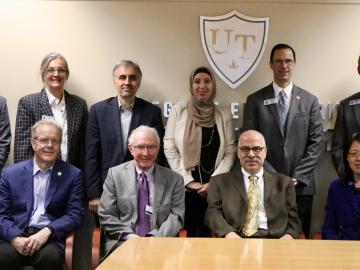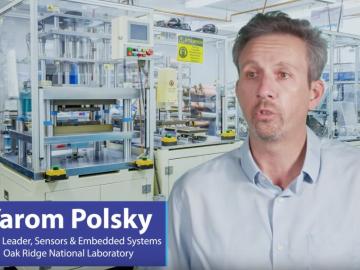
Filter News
Area of Research
- Advanced Manufacturing (11)
- Biological Systems (1)
- Biology and Environment (77)
- Computational Biology (1)
- Computational Engineering (3)
- Computer Science (7)
- Energy Science (84)
- Fusion and Fission (5)
- Fusion Energy (3)
- Isotope Development and Production (1)
- Isotopes (19)
- Materials (117)
- Materials Characterization (2)
- Materials for Computing (17)
- Materials Under Extremes (1)
- Mathematics (1)
- National Security (22)
- Neutron Science (35)
- Nuclear Science and Technology (5)
- Quantum information Science (2)
- Supercomputing (53)
- Transportation Systems (1)
News Type
News Topics
- (-) Artificial Intelligence (60)
- (-) Bioenergy (65)
- (-) Biology (74)
- (-) Biomedical (41)
- (-) Clean Water (23)
- (-) Composites (26)
- (-) Cybersecurity (26)
- (-) Frontier (20)
- (-) Isotopes (38)
- (-) Materials (105)
- (-) Materials Science (105)
- (-) Mathematics (8)
- 3-D Printing/Advanced Manufacturing (95)
- Advanced Reactors (27)
- Big Data (37)
- Biotechnology (21)
- Buildings (46)
- Chemical Sciences (57)
- Computer Science (119)
- Coronavirus (34)
- Critical Materials (25)
- Education (3)
- Element Discovery (1)
- Emergency (1)
- Energy Storage (88)
- Environment (126)
- Exascale Computing (17)
- Fossil Energy (2)
- Fusion (35)
- Grid (45)
- High-Performance Computing (55)
- Hydropower (8)
- Irradiation (2)
- ITER (6)
- Machine Learning (37)
- Mercury (9)
- Microelectronics (1)
- Microscopy (39)
- Molten Salt (8)
- Nanotechnology (47)
- National Security (38)
- Neutron Science (91)
- Nuclear Energy (63)
- Partnerships (35)
- Physics (46)
- Polymers (28)
- Quantum Computing (19)
- Quantum Science (48)
- Security (20)
- Simulation (27)
- Space Exploration (13)
- Statistics (2)
- Summit (32)
- Transportation (74)
Media Contacts

ORNL and The University of Toledo have entered into a memorandum of understanding for collaborative research.

Processes like manufacturing aircraft parts, analyzing data from doctors’ notes and identifying national security threats may seem unrelated, but at the U.S. Department of Energy’s Oak Ridge National Laboratory, artificial intelligence is improving all of these tasks.

The National Alliance for Water Innovation, a partnership of the Department of Energy’s Oak Ridge National Laboratory, other national labs, university and private sector partners, has been awarded a five-year, $100 million Energy-Water Desalination Hub by DOE to address water security issues in the United States.

Three researchers at Oak Ridge National Laboratory will lead or participate in collaborative research projects aimed at harnessing the power of quantum mechanics to advance a range of technologies including computing, fiber optics and network

Quanex Building Products has signed a non-exclusive agreement to license a method to produce insulating material from ORNL. The low-cost material can be used as an additive to increase thermal insulation performance and improve energy efficiency when applied to a variety of building products.

Researchers at Oak Ridge National Laboratory proved that a certain class of ionic liquids, when mixed with commercially available oils, can make gears run more efficiently with less noise and better durability.

A team including Oak Ridge National Laboratory and University of Tennessee researchers demonstrated a novel 3D printing approach called Z-pinning that can increase the material’s strength and toughness by more than three and a half times compared to conventional additive manufacturing processes.

Electro-Active Technologies, Inc., of Knoxville, Tenn., has exclusively licensed two biorefinery technologies invented and patented by the startup’s co-founders while working at the Department of Energy’s Oak Ridge National Laboratory. The technologies work as a system that converts organic waste into renewable hydrogen gas for use as a biofuel.

IDEMIA Identity & Security USA has licensed an advanced optical array developed at Oak Ridge National Laboratory. The portable technology can be used to help identify individuals in challenging outdoor conditions.

Oak Ridge National Laboratory is training next-generation cameras called dynamic vision sensors, or DVS, to interpret live information—a capability that has applications in robotics and could improve autonomous vehicle sensing.


